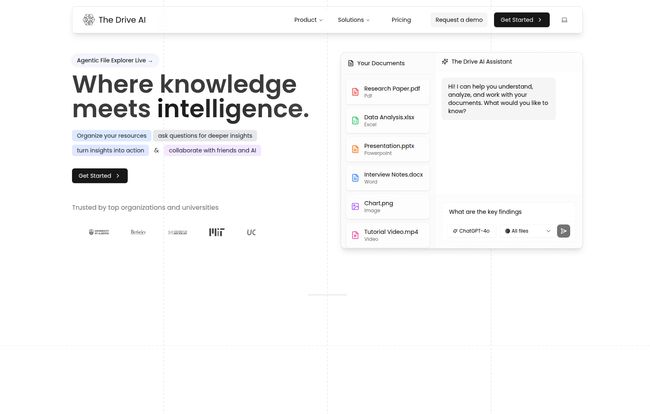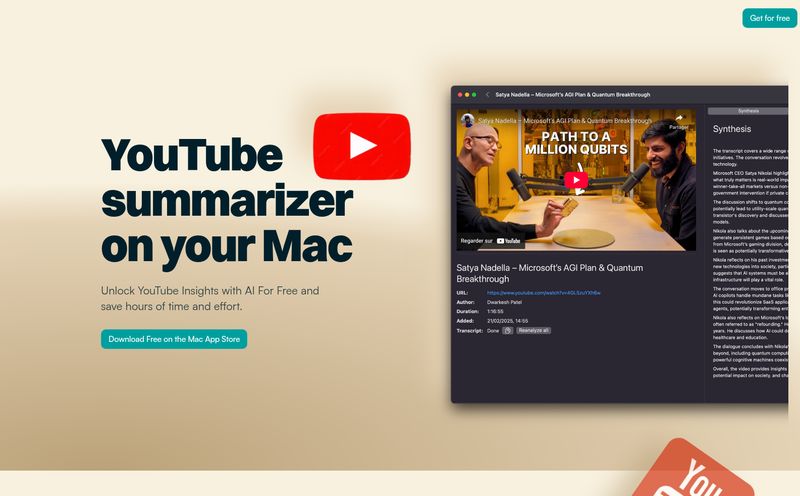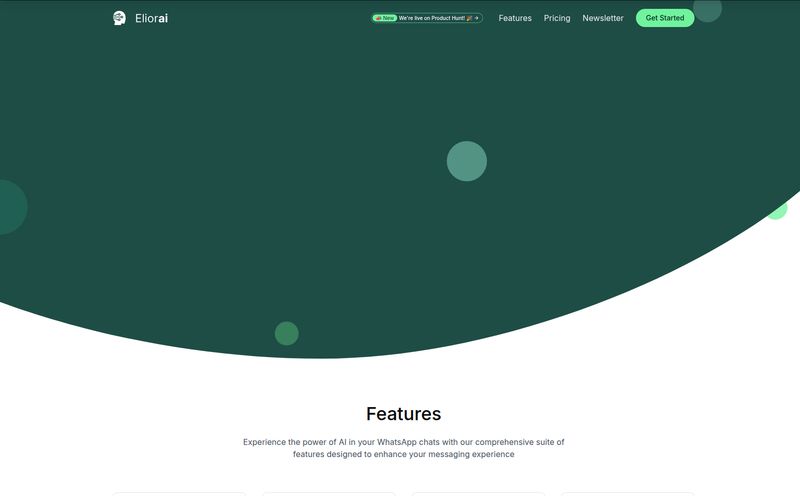My digital life is a catastrophe. My desktop looks like a yard sale after a tornado, my Google Drive is a labyrinth of untitled documents and forgotten folders from 2017, and my Notes app... well, let's not even talk about the Notes app. For years, I’ve been hunting for that one magical tool to tame the chaos. The one that doesn't just store my stuff but actually understands it.
We’ve all been there, right? Frantically searching for that one statistic buried in a 50-page PDF report for a client. Or trying to remember the key points from a YouTube tutorial you watched two weeks ago. It’s a digital scavenger hunt, and I, for one, am tired of playing.
So when I first heard about The Drive AI, my inner cynic, honed by years of sifting through overhyped tech, just rolled his eyes. “Oh, great,” I thought, “another ‘AI-powered’ solution.” But I gave it a shot. And I have to say, I'm genuinely, surprisingly impressed. This thing is less like another dusty digital shelf and more like a librarian for your brain's attic.
So What Exactly is The Drive AI? (Beyond the Buzzwords)
Forget thinking of it as just another cloud storage service like Dropbox or Google Drive. That's not the game it's playing. The Drive AI's whole pitch is turning your random collection of files into a cohesive, intelligent, and conversational knowledge base.
Imagine if your file storage system and ChatGPT had a very smart baby. That's the closest analogy I can come up with. You don't just dump your files there; you upload them into a space where an AI can read, analyze, and then discuss them with you. The platform’s mantra is simple: Store, Read, Write, & Chat. And it's that last part, the 'Chat' part, that changes everything.

Visit The Drive AI
You’re not just storing data; you're building a personalized brain that you can query in plain English. It's a fundamental shift from searching for a file name to asking for the knowledge inside the file.
The Features That Actually Made Me Pay Attention
A feature list is just a list. What matters is how it works in the real world. Here’s the stuff that genuinely made me go, “Okay, this is different.”
Turning Your Digital Junk Drawer into a Genius
The first thing you do is feed the beast. And you can feed it almost anything. PDFs, Word docs, website links, even audio and video files. This is where it gets really interesting. I threw a link to a one-hour-long YouTube video about a recent Google algorithm update, and a few minutes later, it had a full transcript ready for me. For free. That alone is a pretty killer feature. No more scrubbing through videos to find that one 10-second soundbite. You can now just ask your new AI assistant, “Hey, what did that guy say about semantic search?” and it will tell you.
You Can Actually Talk to Your Documents
This is the core magic trick. Once your files are in The Drive AI, they stop being static objects. I uploaded a bunch of my old SEO audit reports—dense, jargon-filled documents. Instead of having to open each one and use CTRL+F, I could just ask the chat interface:
- “What were the common technical SEO issues I found for e-commerce clients in Q3 last year?”
- “Summarize the key findings from the 'Client_ABC_Report_Final_v3.pdf' in five bullet points.”
- “Pull all the quotes I have about Core Web Vitals from my entire knowledge base.”
And it works. It’s not perfect, but it’s shockingly good. It's like having a research assistant who has read every single thing you've ever saved. The time saving potential here is just massive.
An AI Ghostwriter That Knows Your Stuff
The other side of the coin is content creation. Most AI writers, like ChatGPT or Claude, are working from a general model of the internet. They're great, but they don't know your business, your projects, or your specific data. The Drive AI’s writing assistant does. Because it's grounded in the documents you’ve uploaded, it can help you draft content that is contextually relevant to you. You can ask it to “Write a blog post intro about the importance of internal linking, using the data from my uploaded case studies.” It's a completely different, and frankly more useful, approach to AI-assisted writing for professionals.
The All-Important Question: What's the Catch? (And What’s the Cost?)
Alright, it’s not all sunshine and roses. No platform is perfect. The main limitations come down to usage, especially on the lower-tiered plans. You have to pay attention to two things: query limits and queryable document storage. This means you’re limited in how many questions you can ask the AI per day and how much total data the AI can “read” at any given time.
And that “Unlimited storage” they advertise? It’s marked with an asterisk for a reason—it’s a limited-time offer. I'm always a bit wary of promotions like that, but for now, it's a great deal. Let's just hope it sticks around for a while. These limitations are pretty standard for this kind of service, but you need to be aware of them before you dive in.
Breaking Down The Drive AI Pricing Tiers
The pricing structure is actually pretty straightforward, which I appreciate. There are three main tiers:
| Plan | Price | Best For |
|---|---|---|
| FREE | $0 / month | The curious user. With 5 queries/day and 10 MB of queryable docs, it's perfect for testing the waters and managing a few key projects. |
| PRO | $9.99 / month | Freelancers, students, or power users. 100 queries/day and 1 GB of documents gives you a lot more breathing room for serious work. |
| PREMIUM | $19.99 / month | Professionals, researchers, and teams. Unlimited queries, 5 GB of docs, and access to multiple AI models makes this teh professional-grade choice. |
In my opinion, the Free plan is genuinely useful to see if the workflow fits your style. The Pro plan is the sweet spot for most individuals who are sold on the concept. The Premium plan is for those who intend to build their entire team's workflow or research process around this tool. You can find more details on their official pricing page.
Who is The Drive AI Actually For? My Take
While the homepage might suggest it's for everyone, I think it's particularly powerful for a few specific groups:
- Students and Researchers: Being able to dump dozens of academic papers, lecture notes, and source materials into one place and then interrogate them with questions is… a superpower. Seriously. This could revolutionize how research is done.
- Content Creators and Marketers: Like me! I can feed it all my past articles, keyword research, and client briefs to create a central brain for my business. It helps generate new ideas and repurpose old content with incredible efficiency.
- Small Teams and Businesses: Use it to build a searchable knowledge base of internal processes, meeting minutes, project documentation, and onboarding materials. New hires could just ask the AI questions instead of bugging a manager every ten minutes. That's a huge win.
So, Is The Drive AI Worth It?
In a world overflowing with AI tools that all promise to change your life, The Drive AI feels… practical. It’s not trying to be a magical, all-knowing oracle. It's trying to solve a real, tangible problem: our own digital disorganization. It's not just another AI chat bot; it's a tool to build your own AI chat bot, trained on your own expertise.
For me, the ability to centralize my knowledge and then interact with it conversationally is more than just a novelty. It's a genuine productivity booster. It's one of the few new tools I’ve tested recently that I've actually integrated into my daily workflow. And that’s saying something.
Let's Get Your Questions Answered
Frequently Asked Questions about The Drive AI
Can The Drive AI really handle video and audio files?
Yes, and it's one of its best features. When you upload a video (or provide a YouTube link) or an audio file, it will process it and provide a full transcript. You can then query the contents of that transcript just like any other document.
Is my data private and secure on The Drive AI?
Like any cloud service, this is a valid concern. The Drive AI, as a professional tool, operates under standard data privacy and security protocols. Your files are used to provide answers to your queries and are not used to train the public models. For highly sensitive information, you should always review the platform's specific privacy policy.
What AI models does The Drive AI use?
The platform uses a variety of advanced AI models. On the Premium plan, you actually get to choose from multiple options (they state 10+), allowing you to pick the best model for a specific task, whether it's creative writing or technical analysis.
What's the difference between 'queryable document' size and 'storage'?
This is a key point. 'Storage' refers to how many files you can save on the platform (which is currently unlimited for a limited time). 'Queryable document' size is the total size of the files that the AI can actively read and answer questions about at one time. For example, on the Pro plan, you could have 10 GB of files stored, but you can only designate 1 GB of them to be active for AI queries.
Is the free plan actually useful?
Absolutely. 5 queries a day is enough to get a real feel for the platform's power. It's perfect for a single student project, planning a vacation with a few documents, or just satisfying your curiosity. It’s a great, no-risk way to see if it fits your workflow before committing.



